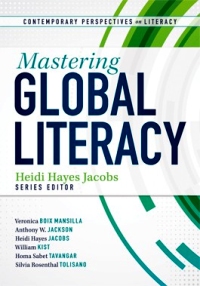“Mastering Global Literacy” is a collection of short articles written to explain how “educators can cultivate globally literate learners while becoming globally connected themselves.” The book’s authors (Veronica Boix Mansilla, Anthony W. Jackson, Heidi Hayes Jacobs, William Kist, Homa Sabet Tavangar and Silvia Rosenthal Tolisano) “explore ways to bring global issues into the classroom and personalize them using new digital tools.” In addition, the advertising blurb promises that readers will find “strategies for implementing global-awareness studies into the traditional school curriculum, as well as creating new types of 21st century learning environments.”
 The aims of this book are laudable, but sadly, in many ways, this book fails to live up to its hype. This is especially true of Chapter 5 (the concluding chapter), “Interdisciplinary Global Issues: A Curriculum for the 21st Century Learner”. The overly US-centric approach adopted in this book is nowhere more obvious than in this chapter. After defining what is meant by global literacy, the chapter considers how the (U.S.) National Geography Standards (NGS) can help educators plan courses that will promote it. The NGS certainly have considerable value in this regard, but (ironically) this chapter might have benefited from also considering a more global perspective such as that adopted by the geography curriculum of the International Baccalaureate’s Diploma Program.
The aims of this book are laudable, but sadly, in many ways, this book fails to live up to its hype. This is especially true of Chapter 5 (the concluding chapter), “Interdisciplinary Global Issues: A Curriculum for the 21st Century Learner”. The overly US-centric approach adopted in this book is nowhere more obvious than in this chapter. After defining what is meant by global literacy, the chapter considers how the (U.S.) National Geography Standards (NGS) can help educators plan courses that will promote it. The NGS certainly have considerable value in this regard, but (ironically) this chapter might have benefited from also considering a more global perspective such as that adopted by the geography curriculum of the International Baccalaureate’s Diploma Program.
Many of the suggestions made in this book for how global literacy can be promoted are already being practiced (and have been for decades) by geography teachers in the U.K., Australia and elsewhere. The idea that geography can be infused into other disciplines has been around for a long time, hence the proliferation of course titles (in many disciplines besides geography) including terms like “Global” and”World”. There is no need to reinvent this particular wheel in developing courses that promote global literacy, and little advantage to be gained from adopting new terminology, such as the proposals for “Geo-economics”, “Geocommunications”, “Geo-arts and literature”, “Geohealth”, “Geosports” and “Geo-education”.
This book is also the latest entrant in our “North America” hall of shame for its description of a “subject-specific strategy” that will boost global literacy in the classroom when “a globally connected educator facilitates the learning”. The strategy is based on a geography lesson in which “A middle school class is studying South America and following, via a blog and Twitter feed, a National Geographic-sponsored trip of a man traveling by bus from the United States to Antarctica. Students learn about the traveler’s different destinations throughout South America: Mexico, Guatemala, the Panama Canal, Colombia, Argentina, and finally, Cape Horn.”
“Houston, we have a problem!”. The suggestion that Mexico, Guatemala and the Panama Canal are located in South America is a classic example of geo-illiteracy and, as such, completely out of place in a book about global literacy.
Conclusion? While this book does have some valuable sections, it offers far less to geographers than its promotional materials would suggest. Given its title, the book’s failure to engage with modern geography (as practiced outside the USA) is a major limitation.
Mastering Global Literacy. Contributors: Veronica Boix Mansilla, Anthony W. Jackson, Heidi Hayes Jacobs, William Kist, Homa Sabet Tavangar, Silvia Rosenthal Tolisano. 136 pages. Solution Tree. 2013.
Related posts:
Sorry, the comment form is closed at this time.